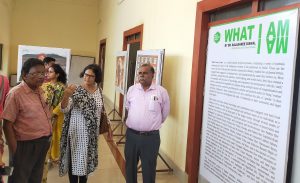Art Exhibition ‘What I Am, I Am’: An Ode To World’s Indigenous People

Baripada: The Department of Anthropology and Tribal Studies (ATS), Maharaja Sriram Chandra Bhanjadeo University (MSCBU), in collaboration with the Department of Santali and the Departments of Anthropology and Santali (MPC Auto. College) Baripada as well as the New Bridge India (Bhubaneswar), celebrated International Day of the World’s Indigenous Peoples at the Centre for Tribal Studies building (CTS Building), MSCB University on August 9.
The theme of this year’s celebration is the “Role of indigenous women in the preservation and transmission of traditional knowledge.”
Chief guest Dr Rajkishor Naik exhorted everyone to uphold tribal rights, dignity over land and other natural resources. Prof. Kishor Basa, Vice-Chancellor of the University, emphasised the need for inclusiveness and understanding of tribal perspectives. Dr Basanta Kumar Mohanta, Head of the Department of Anthropology and Tribal Studies urged students to make a community-participated museum in the University.
The art exhibition “What I am, I am” is an educational art project with artworks by Dr Rajashree Biswal, an internationally recognised art historian, cultural thinker and co-initiator of New Bridge India. The exhibition intends to create awareness among students and the public about the crucially significant grassroots level Adivasi women who have brought about changes in their life, within the community and society at large. It is quite befitting to the theme of International Indigenous Day, 2022. Supported by Sarat Chandra Library, it was inaugurated by chief guest Dr Rajkishor Naik and Prof. Kishor Basa, Vice Chancellor of the University.
The exhibition is on till August 13 at the University premises. Dr Rajashree Biswal and internationally reputed contemporary visual artist Birendra Pani, co-initiator of New Bridge India talked about the exhibits saying that these Adivasi women followed their instincts, chased their dreams, treaded the uncharted terrain, struggled hard, engaged in a sustained way, and championed the cause they believe in. Dr Biswal said that through their lives, practices, world-views and world-making perspectives, they have created a new paradigm of knowledge and experience for reconnecting with Earth and a life of sustainability and equality. Despite limitations and challenges in the social, economic, psychological, cultural and political spheres, these women have not only redefined the concept of gender in their personal lives but have reconfigured the concept of leadership in their communities and larger social spheres.
The exhibition highlights 14 digital portraits of important tribal women of Odisha and India – agriculturist and paddy seed preserver Padma Shri Kamala Pujari, agriculturist and biodiversity preserver Raimati Ghiuria, environmentalist Padma Shri Tulsi Gowda of Karnataka, and traditional medicine practitioner Padma Shri Lakshmi Kutti Amma of Kerala
were exhibited in the domain of conservation and dissemination of traditional knowledge, maintaining ecological and biodiversity.
There are also portraits of a group of women who are preserving cultural forms and their diversity e.g, Saura exponent Lakhmi Sabara, iconic Dalkhai dancer late Gurubari Mirdha, folklorist Padma Shri Sukri Bammagowda of Karnataka, Santali writer Padma Shri Damayanti Besra, Kutia Kondha folklorist Basanti Majhi and Pallavi Durua – the first tribal queen- Adi Rani. Yet another group of women had worked in the sphere of socio-political leadership, tribal leader Droupadi Murmu-India’s first tribal President, social activist and educationist Padma Shri Tulasi Munda, forest and land rights activist Anna Kujur, Dongaria Kondha leader and forest right activist Dinja Jakesika and environmental activist Padma Shri Jamuna Tudu whose work on issues of tribal communities, modernity, development and mainstreaming have paved the way for a dignified life in the contemporary times.

Dr Biswal further added that these crucially significant women have created a new paradigm of interaction and exchange of knowledge and experiences of ‘indigeneity’ and ‘modernity’ and have redefined Adivasi identity, subjectivity and agency in contemporary times.
The symbols, motifs, colour schemes and atmosphere of the digital images reflect the different personalities and qualities of the protagonists, accentuating their distinct engagement in their socio-cultural context. It is encouraging a new (cultural) sensibility and awareness among the audience. Hundreds of students, faculties from different departments of the University as well as well-known economist and former director of Nabakrushna Choudhury Centre for Development Studies Prof. Srijit Mishra were present on the occasion and viewed the exhibition. Dr Rajkishor Naik appreciated it as a highly research-based and enriching experience. Prof. Basa was extremely happy sharing it as a very significant exhibition. Prof. Srijit Mishra lauded the exhibition as being of global standards.
Following the interest of Prof. Mishra and Prof. Basa, the theme of the exhibition “What I am, I am!!” was translated and the statement was delivered in various languages by the students and faculty of the university where Seemamani Majhi spoke in Santali, Sabita Singh in Mundari, Sumitra Purty in Ho, Sanjay Mahali in Mahali, Shriya Mohanta in Kudmali, Subhadra Nath in Odia, Dr Priyanka Das in Hindi, Dr Monali Goswami in Bengali and Dr Rajashree Biswal in English to promote linguistic and cultural diversities in a symbolic gesture. They performed the Santali dance in the natural ambience of the scenic and beautiful atmosphere of the MSCBU making it a true celebration of the spirit of the indigenous community in contemporary times.

Comments are closed.